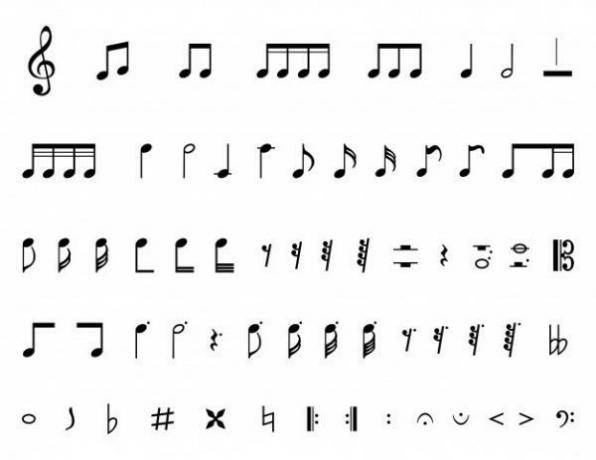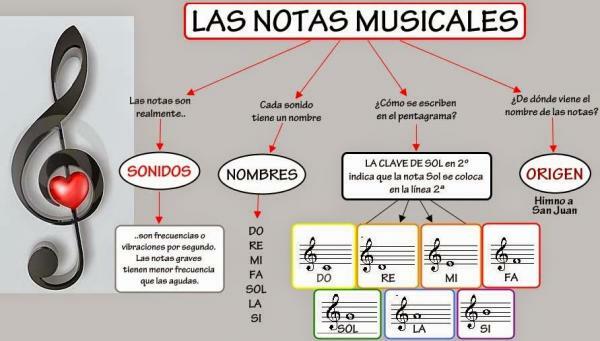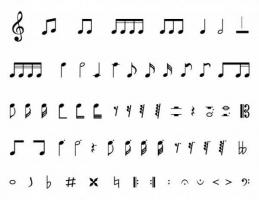MUSICAL NOTES: symbols and names

Communication is a crucial factor for the human being, not only as a survival tool but also as a method of expression and evolution. Through language, we can communicate both simple and complex ideas, which have the ability to transform and affect others and even ourselves.
There are many languages, taking into account the spoken, the written, the visual... and all possible combinations. Music is also a language, and therefore we must learn its letters, symbols and forms of punctuation. In this lesson from a TEACHER we will talk about musical notes: symbols and names, since they are the basis of musical writing.
Index
- What is a musical note
- Musical notes: the symbols
- Musical note names and characteristics
What is a musical note.
The word "note" comes from the latin word "Gnoscere" that is related to a brand, a symbol that we recognize. So the main function of a note is to "write down" to leave something in writing to read or remember it later.
Just as there are letters in the text we read every day, the notes in music would be the equivalent of them. They are all these symbols that, when combined, allow us to form sentences.
The musical notesdiffer from the text because they have two important elements we play with: rhythm and tuning:
- Rhythm: refers to a measure of frequency in relation to time, that is, how many times a note is played in a given period of time.
- Tuning: and then tuning is the concept of height, how acute (high) or serious (low) a note sounds.

Image: Slideshare
Musical notes: symbols.
Since we have these two factors to write down, there is a system with which we can read this simultaneously.
Rhythm
For the rhythm we use musical figures, These symbols are ways of drawing the notes in order to differentiate them depending on how long they should last. The compassin music it is the measure that delimits a certain number of notes and the number of measure or metrics, is what tells us how many notes we can write on it. For example, in a 4/4 time signature we have 4 beats, so the notes that we can write in must equal those 4 beats, in total.
The longest rhythmic musical figure is the roundand lasts 4 times. From it we can indicate the rest of the figures, from long to short:
- Round: 4 times.
- White: 2 times.
- Black: 1 time.
- Quaver: ½ time.
- Semiquaver: ¼ of time.
- Fusa: 1/16 of the time
- Semi-Fusa: 1/32 of the time.
The figures that we have mentioned before are of binary base (base of 2), but we also have figures of ternary base:
- Triplet: 1/3 of the time.
- Sextuplet: 1/6 of the time.
Based on these ternary figures we also have longer figures:
- Black triplet: Equivalent to 2 triplets.
- Blanca's triplet: It is equivalent to 2 triplets of quarter note.
Finally, we have the "punctilio", which is a dot that is placed next to the note to indicate that it lasts for its entirety plus half its duration. A couple of examples:
- Dotted white: 2 times + ½ white time (1 time). Total: 3 times.
- Black: 1 beat + ½ quarter note (1/2 beat). Total: 1 ½ times.
Silences
Another very important factor in music happens not only when we are playing a note, but when we stop playing it. We call the symbol to indicate that we do not play a note “silence”. Each musical figure that we mentioned above has a silence of the same duration. For example, the round has the silence of the round (which lasts 4 beats) and the quarter note has a silence of the quarter note (1 beat). This also applies to the dots.
Tuning
We measure this factor in music by height, how acute (high) or serious (low) a note sounds. We can visualize this graphically with the help of the staff which is how we call the five lines where the musical notes are written. In the staff we use both the lines and the spaces, the higher a note is, the higher it is, and the opposite for the low notes. Lines and spaces on the staff are counted from bottom to top.
Names of musical notes and characteristics.
In the western system (which is the universally established system) the marks are 7. These are: Do, Re, Mi, Fa, Sol, La Y Yes, in this specific order. Unlike rhythm, its symbols do not change, but its placement on the staff does.
Each line or space has a note assigned depending on the musical clef, which is what tells us from which part of the staff we can start counting the notes. For example, in the treble clefthe second line of the pentagram is sol. That means the next space up is the note A, and the space below it is Fa.
These, in turn, may have a disturbance which is marked on the staff with the symbols # (sustained) and b (flat) and means that its pitch changes half a tone up (if sharp) or down (if flat). When a note is altered, its name does not change, but it indicates that it has been altered. For example: G # (G sharp).
As you can see, music is a language unto itself. It is important to learn its rules so that we can communicate when talking about music and thus be able to play and enjoy it with the greatest possible understanding.

Image: School of Music
If you want to read more articles similar to Musical notes: symbols and names, we recommend that you enter our category of Musical language.


